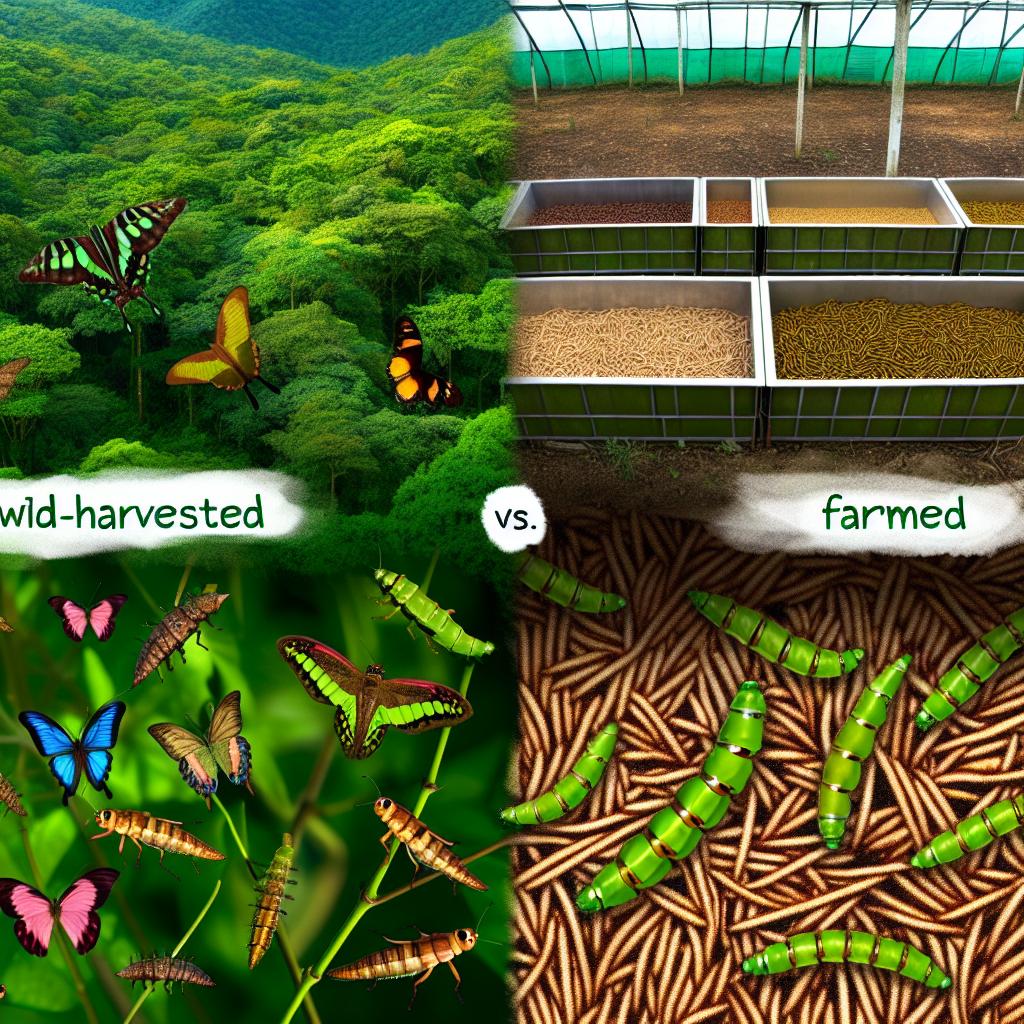Introduction
In recent years, insects have gained attention as a sustainable and nutritious food source. As the global population increases, food security becomes a more pressing issue, making the exploration of alternative protein sources essential. Insects offer a credible solution, but not all insects are sourced in the same way. Understanding the differences between wild-harvested and farmed insects is critical for consumers and producers alike.
Wild-Harvested Insects
Wild-harvested insects are collected directly from their natural habitat. This method of sourcing has been practiced for centuries in many cultures. In regions such as Southeast Asia and Africa, wild-harvesting remains an essential practice. The traditional knowledge embedded in these communities offers insights into sustainable management of natural resources.
Ecological Impact: The impact of harvesting insects in the wild can be substantial. Over-harvesting can result in the depletion of local populations, potentially disrupting ecosystems. However, when done sustainably, it can be part of an ecological balance. There are models of community-based management where local groups regulate the collection and ensure habitats remain intact.
Nutritional Content: The diet and habitat of wild insects can influence their nutritional content, making them a diverse source of nutrients. These insects often feed on native plants, which can contribute to a varied nutritional profile. However, their unpredictable diet can sometimes result in variable nutritional profiles compared to farmed insects. Factors such as geographical location, season, and available flora further contribute to these differences.
Challenges: One of the main challenges with wild-harvested insects is the potential presence of contaminants or pathogens. This risk necessitates thorough cleaning and cooking to ensure safety. Traditional preparation techniques often mitigate these risks; however, best practices need to be adapted to modern conditions, especially as global interest increases. Moreover, variability in availability can pose challenges for consistent supply, especially in the face of climatic changes and habitat disruptions.
Farmed Insects
Farmed insects are raised in controlled environments to ensure consistent quality and supply. This method is gaining popularity as the demand for edible insects increases. Farms employ technology and scientific approaches to optimize growth conditions.
Controlled Environment: Farming insects allows for a controlled environment in terms of diet, habitat, and breeding conditions. This control ensures more uniform nutritional content and reduces the risk of contamination. For example, the feed for farmed insects can be precisely engineered to enhance certain nutritional outputs, making the insects a tailored source of protein and micronutrients.
Sustainability: In terms of sustainability, farmed insects require minimal resources compared to traditional livestock. They use less land, water, and feed, making them an environmentally friendly protein source. The lifecycle assessment of insect farms often highlights their reduced carbon footprint. Additionally, they can be integrated into urban settings, reducing transport emissions and fostering local food production cycles.
Scalability: Farmed insects offer the advantage of scalability, allowing production to meet increasing demand. This scalability also facilitates research and innovation in insect-based food products. Automation and technology can further enhance efficiency, making it more feasible to expand operations quickly. However, to achieve true scalability, regulatory frameworks need adjustment, and market acceptance must grow.
Economic Factors
There are economic considerations when choosing between wild-harvested and farmed insects. Wild-harvested insects often support local economies and can be a lifeline for rural communities. They provide supplementary or primary income and support traditional practices, which are an integral part of cultural heritage.
Conversely, established insect farms can provide consistent employment and opportunities for technological advancements. Such farms can drive innovation in food production, contributing to economic growth. They also offer an opportunity for developing new markets, creating a ripple effect in associated industries such as feed production and processing technologies.
Societal Acceptance and Cultural Significance
While insects have been consumed in various cultures for centuries, introducing them as mainstream food can face resistance in areas unaccustomed to entomophagy. Social acceptance varies significantly across regions, often influenced by historical dietary practices and cultural attitudes towards insects.
The cultural significance of insects should not be underestimated. In many societies, certain insects have festival or ritualistic importance, adding layers of meaning to their consumption beyond nutrition. Recognizing and respecting these cultural contexts is crucial in global dialogues about food security and diversity.
Conclusion
Both wild-harvested and farmed insects play valuable roles in the global food system. The choice between the two often depends on factors such as sustainability, nutritional consistency, and economic impact. An integrated approach that respects traditional knowledge while embracing modern technology can pave the way for a more sustainable food future.
As the industry evolves, it is crucial to balance these factors to ensure a sustainable and nutritious food future. For those interested in the potential of insects as a food source, understanding these differences is the first step. Holistic approaches that combine economic, ecological, and cultural insights will likely be the most successful in positioning insects as a staple protein source in the years to come.
For more information on sustainable eating, visit Food and Agriculture Organization of the United Nations.

